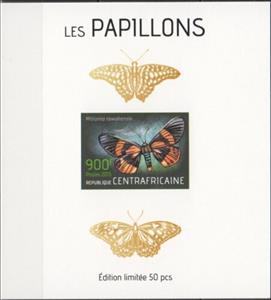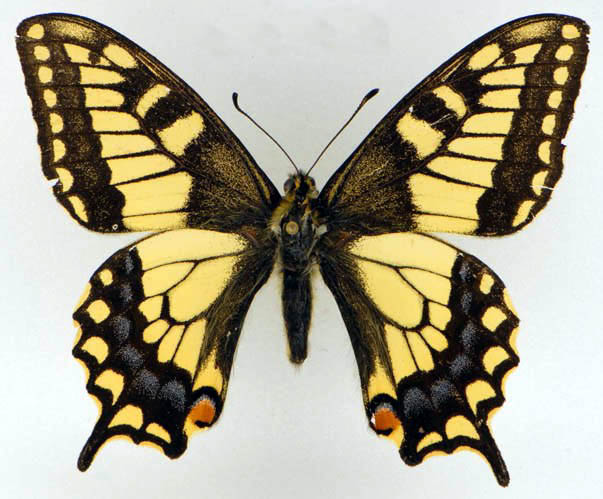Souvenir Sheet: Butterflies Gold Impressions (Central African Republic 2013)
Butterflies Gold Impressions (Central African Republic 2013)
01 January (Central African Republic ) within release Butterflies (2013) goes into circulation Souvenir Sheet Butterflies Gold Impressions face value 900 Central African CFA franc
| Souvenir Sheet Butterflies Gold Impressions in catalogues | |
|---|---|
| Colnect codes: | Col: CF 2013-06 |
Souvenir Sheet is square format.
"Limited issue" deluxe souvenir sheets like this based off the original productions by Stamperija were produced. This series taken from the Stamperija produced Butterflies series. Origins of the deluxe sheets is unclear. These counterfeit panes were never offered on the Stamperija website and were and are only offered by exclusive counterfeit distributors in Eastern Europe. These are not listed to exist in any catalog. The counterfeits have extreme differences in colors and the stamp images are "blurry" in comparison with the genuine stamps. These are claimed to be " limited UV cardboard" having "OFFICIAL" inscribed on the back which is seen under UV light. The inscription at the bottom translated is "Limited edition of 50 units". The whole series (both gold and silver) have been extensively sold by Eastern European and Russian sellers. They are still offered to this day by several exclusive Eastern European and Russian counterfeit distributors who are asking overinflated prices. Anyone selling these should be avoided!Also in the issue Butterflies (2013):
- Souvenir Sheet - Butterflies Gold Impressions face value 900;
- Souvenir Sheet - Butterflies Gold Impressions face value 900;
- Souvenir Sheet - Butterflies Gold Impressions face value 900;
- Souvenir Sheet - Butterflies Gold Impressions face value 900;
- Souvenir Sheet - Butterflies Gold Impressions face value 3,000;
- Souvenir Sheet - Butterflies Silver Impressions face value 900;
- Souvenir Sheet - Butterflies Silver Impressions face value 900;
- Souvenir Sheet - Butterflies Silver Impressions face value 900;
- Souvenir Sheet - Butterflies Silver Impressions face value 900;
- Souvenir Sheet - Butterflies Silver Impressions face value 3,000;
Souvenir Sheet Butterflies Gold Impressions it reflects the thematic directions:
Animals are multicellular, eukaryotic organisms of the kingdom Animalia (also called Metazoa). All animals are motile, meaning they can move spontaneously and independently, at some point in their lives. Their body plan eventually becomes fixed as they develop, although some undergo a process of metamorphosis later on in their lives. All animals are heterotrophs: they must ingest other organisms or their products for sustenance.
Lepidoptera or lepidopterans is an order of winged insects which includes butterflies and moths. About 180,000 species of the Lepidoptera have been described, representing 10% of the total described species of living organisms, making it the second largest insect order (behind Coleoptera) with 126 families and 46 superfamilies, and one of the most widespread and widely recognizable insect orders in the world
Insects (from Latin insectum, a calque of Greek ἔντομον [éntomon], "cut into sections") are a class (Insecta) of hexapod invertebrates within the arthropod phylum that have a chitinous exoskeleton, a three-part body (head, thorax and abdomen), three pairs of jointed legs, compound eyes and one pair of antennae. They are the most diverse group of animals on the planet, including more than a million described species and representing more than half of all known living organisms. The number of extant species is estimated at between six and ten million, and potentially represent over 90% of the differing animal life forms on Earth. Insects may be found in nearly all environments, although only a small number of species reside in the oceans, a habitat dominated by another arthropod group, crustaceans. The life cycles of insects vary but most hatch from eggs. Insect growth is constrained by the inelastic exoskeleton and development involves a series of molts. The immature stages can differ from the adults in structure, habit and habitat, and can include a passive pupal stage in those groups that undergo 4-stage metamorphosis (see holometabolism). Insects that undergo 3-stage metamorphosis lack a pupal stage and adults develop through a series of nymphal stages. The higher level relationship of the Hexapoda is unclear. Fossilized insects of enormous size have been found from the Paleozoic Era, including giant dragonflies with wingspans of 55 to 70 cm (22–28 in). The most diverse insect groups appear to have coevolved with flowerin plants.



